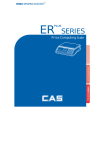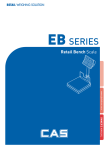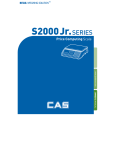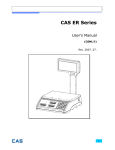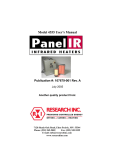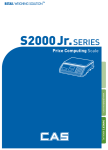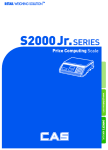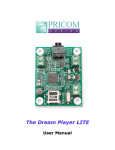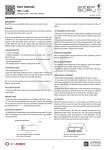Download DWC282 283 Svc manu..
Transcript
l Service Manual For electronic dual temperature zone wine cellar Includes DWC282 / 283 This is a service guideline for possible failure and repair. Warning: before attempting any cleaning or maintenance this unit MUST be disconnected from the supply, to prevent electrical shock ▲ Preparation before maintenance ○ Equipment 1/ Small bench Vise 2/ Set of Phillips head screwdrivers 3/ Seal pliers 4/ Electrical Multi meter 5/ Amp meter (5A) (caliper cable type) 6/ Electrical soldering iron 7/ Wire strippers 8/ Scissors 9/ Vacuum pump 10/ Soldering iron for copper pipes ▲ Cooling system fault ○ How to Evaluate the fault ...…………………………………………………(Page 3) ○ How to repair the fault … ……………………………………………… ………(Page 3) ○ How to remove the air duct board ..……………………………………………. (Page 3) ○ Diagram showing the front side soldered joints … ..………………………(Page 8) ○ Diagram showing the rear side soldered joints ……………………………………(page 8) ▲ Heating system fault ○ How to Evaluate the fault ……………………………………………………….(Page 9) ○ How to repair the fault ………………………………………………… .………(Page 9) ▲ Noise problems ○ Compressor noise .…………………………………………………..………(Page 9) ○ Fan noise …………………………………………………………..……….(Page 9) ○ Refrigerant jet noise ……...…………………………………………...……… (Page 12) ○ Capillary vibration noise ……………………...………...……………………. (Page 12) ○ Oil jam noise ……………………………………..…...………………….(Page 12) ▲ Evaporator freezing problems ... ………………………………………...………. (Page 12) ▲ Unstable internal Temperature ... …………………………...…………… (Page 13) ? Control system problems ? Fault finding by the self-check mode ……………………………………(Page 13) ? Sensor fault ,…………………………………………………………….(Page 13)] ? How to replace the sensor …………………………………………………(Page 14) ? LED display fault …………………………………………………………….(Page 16) ? How to remove parts inside of electrical box …………………………… (Page 16) 2 / 18 3 / 18 △ Cooling system faults. ○ How to diagnose faults: It should take approximate 3 hours to reach the lowest setting temperature of 5℃ for an empty unit (assuming ambient temp of 32 degrees centigrade and continuous operation). If not, check the compressor, cooling fans, controller, and sensors. If all these are working normally, there is probably a cooling pipe fault. ○ Check points 1/ Compressor: Warning this check requires the power to be on, take extra care and consult a qualified electrician Turn on the unit and check there is electricity current flowing to the compressor using a caliper type Amp meter, the current should be within 0.6 to 2 Amps. If the readings are not in this range, turn off and cut off the pipes (G and E see Fig.12) from the compressor, then turn the unit on again (in this case only run the compressor for a few minuets) and recheck the current and if there is pressure at the outlet pipe. If the current reading is still out of range specified above and no pressure from the compressor outlet, replace the whole compressor 2/ to check the cooling system pipe work Carefully check the cooling system after verifying the compressor is working normally. Then follow the procedure below 2.1>Check for leaks. Then cut off process pipe and check the refrigerant. If there is not enough refrigerant, this indicates a small leak isolate the leak and repair it (see below), recharge the system with the correct amount of refrigerant, (0.8-1Mpa of nitrogen) 2.2>. a. Cut off discharge pipe from compressor and charge with refrigerant to 0.8—1Mpa nitrogen via the process pipe. Then place your hand close to the broken end of discharge pipe, if you can feel a little airflow, this proves the capillary is normal, if not it means the capillary is jammed. b. Weld the broken discharge pipe if capillary works normal, then charge to 0.8—1Mpa nitrogen via the process pipe and check if there are any leaks from every soldered joint of the cooling system using soapy water and looking for tiny bubbles, Check the soldered joints around the compressor first (Fig.12), then check the soldered joints around the evaporator see (Fig.11). Remove the air duct board when you check the evaporator joints, see (Page 3). c. If there are no leaks. The faults are A leak in the condenser or anti-dew pipe Or a fault of one of the other components in the unit, These internal leaks cannot be repaired. 2.3>. If there are no leaks in the cooling system pipe work 3/ Refill the refrigerant: 1>. Using the vacuum pump form a vacuum in the system, via the joint of the low-pressure pipe, the high-pressure pipeline is on the process pipe of the drain filter. Apply the vacuum pump for approximately 20 minutes. Until the vacuum is lower than 100Pa. Then solder the drainpipe. Keep the vacuum running while soldering this joint 2>. Fill Cooling system with refrigerant via the process pipe. (The refrigerant is R134a. Regarding refrigerant quantity Please refer to the instruction at back label of wine cellar). Then solder the compressor process pipe after the system is charged with refrigerant. 4/ Running test: Replace all the components after the procedures above and turn the unit on. To verify the effectiveness of the repair, monitor the unit the compressor should automatically stop within + or - 2.5 deg centigrade of the set temperature within approx 3 hours (assuming an ambient temperature of 32℃and the unit is empty) ○ How to remove the air duct board. 1>. Remove the shelves; some models have Phillips head screws to hold other models have no screws (Fig.1) 4 / 18 Fig.1 2>. 2>. Remove the electric box. There are two. For old version, see below ① To disassemble the old version a. Remove box fixing screws (1,2,3,4), See (Fig.2). (The right hand diagram is for reasons of clarity only). Fig.2 b. Pull out electric box to expose the control panel as per the direction of arrowhead, then unplug all the connectors from the control panel, and remove electric box (A). See (Fig.3) (Fig.4) Shows the new version of the control panel 5 / 18 Fig.3 Fig.4 1. 2. 3. 4. 5. 6. 7. 8. 9. 10. New version control panel connections To the fan of the refrigeration compartment (F3 White). To the air cycling fan.(F2 Yellow) To the fan of the freezing compartment.(F1 red) To the sensor of the freezing compartment (X1 yellow) To the sensor of the refrigeration compartment (X10 White) To the sensor of the evaporator (X11 Red) To the power supply (L,N) To the grounding or earth To the PTC heater (X9 White) To the compressor (X3 White) 6 / 18 c. Remove screws (6,7,8,9,10,11), then remove the lower cover of middle air duct board: (Fig.5) Fig.5 d. Remove screws (12,13,14,15,16,17), then remove the upper cover of the middle air duct board (G) to expose the air duct board. See (Fig 6) Fig.6 ② To disassemble the new version a. Remove the shelves then remove the fixing screws (2,3). (The right hand diagram shows the box for clarity only). See (Fig 7) 7 / 18 Fig.7 b. Remove the upper cover of middle air duct board (A), then unplug all connectors from the control panel: (Fig 8). The connections of the control board are as per (Fig.4). c. Remove the fixing screws (7,8,9,10,11,12), then pull out electric box (C) to expose the air duct board; (Fig.9) Fig.9 8 / 18 3>. Remove the fixing screws of air duct board (1,2,3,4,5,6), then pull out air duct board (A). See (Fig 10) Fig.10 4>. For a View of the internal configuration after removal of the air duct board, see (Fig.11) ○ Front side joints location. See (Fig.11) A. Capillary soldered joints B. evaporator soldered joints ○ See (Fig.12) for a rear side view of the joints position. B. Dry filter process pipe soldered joint C. Dry filter soldered joint. D. Capillary soldered joint E. Process pipe soldered joint. F. Suction pipe soldered joint G. Discharge pipe soldered joint H. Condenser process pipe soldered joint I. Anti-Dew pipe soldered joint 9 / 18 ▲ Heating system faults ○ How to diagnose faults: If the temperature of refrigeration compartment is (-2℃) lower than setting temperature for an empty unit (assuming ambient temp of over 0 degrees centigrade and continuous operation and normal temperature of the freezing compartment), check the heater fan and PTC heater. If both are working normally, there is probably a heating system fault. ○ How to repair the fault: 1. How to check the heater fan. If the temperature of refrigeration compartment is lower than set temperature but heater fan does not function, after verifying no bad connections replace the fan unit (Fig.13) 2. How to check the PTC heater Check the resistance at both sides of PTC heater using a Multi meter; the reading should be approx 1.5 KΩ (assuming normal temperature), if open circuits Replace the PTC heater having once verified the connections to the PTC heater. See (Fig.11) 3. If no fault in the fan or PTC heater, replace the control panel, see (Page 16). ▲ High noise of wine cellar ○ compressor noise 1. The working of motor and piston motion will cause noise when compressor working. So if noise is steady and not exceeds 42 dB, it’s normal. If noise is not steady or very high, it’s compressor fault and it should be maintained or replaced. 2. If compressor’s shock absorption rubber is hardening or damaged, or fixing screw of compressor is too tight or loose, it will cause noise. The settlement is to change new shock absorption rubber or adjust fixing screws. ○ fan noise 1. Normal fan motor and airflow should not exceed 32 dB. 2. If there is noise above 32BD or the noise levels fluctuate the fan shaft is either damaged or worn. 3. How to replace the fans 1>. Heater fan. a. Remove the shelves. See (Fig.1) b. Remove the electric box. See (Page 4) c. Remove the air duct board. See (Fig.10) 10 / 18 d. Remove screws (1,2,3,4), then replace the heater fan. See (Fig.13) Fig.13 2>. Air cycling fan and evaporator fan. ①. If the unit has an new style electrical box a. Remove the shelves and screws (1,2), then pull out the upper cover of the middle air duct board (A); See (Fig.14) b. Then remove the foam (B), (Caution: Do not damage the foam). See (Fig.14) Fig.14 c. Remove the fixing screw (3), then remove the sensor(C); See (Fig.15) 11/ 18 Fig.15 d. Remove the fixing screws (1,2,3,4), then remove the air cycling fan (A). See (Fig.15.1); Remove the fixing screws (5,6,7,8), then remove the condenser fan (B). See (Fig.15.1); and replace them separately. Fig.15.1 ②. If the unit has an old style electrical box, a , Remove the lower cover of middle air duct board, See (Fig.5),then remove the foam(A), See (Fig.16) b , Remove screw(9) ,then remove the sensor(D) ;See (Fig.16) c , Remove screws(1,2,3,4 ) ,then remove air cycling fan(C) ;See (Fig.16) Remove screws(5,6,7,8 ) ,then remove evaporator fan(B) ;(Fig.16) Then replace them separately。 12 / 18 Fig.16 Refrigerant jet noise If here is continuous noise like a water spray from the capillary, the end of the capillary is in the wrong position, or there are rough edges on the end of the capillary 1>. Heat the soldered joint of the capillary (“A” of Fig.11), then remove the capillary from the evaporator and smooth the end with an eraser. (Caution: do not allow any particles into capillary unit) 2>. Replace the capillary into the evaporator, then solder it back into the correct position (not exceeding 15mm in the evaporator) and pack the joint with anti vibration compound 3>. Recharge with refrigerant. See (Page3) ○ Capillary vibration noise Fault: high frequency impact noise in capillary Zone. Caused by either: 1>. The capillary being insert too deep into the evaporator, so when the refrigerant is Jetting, the end of vibrating capillary will hit the inside of the evaporator. 2>. Vibration from the capillary touching the inside of the cabinet or air duct board, then when refrigerant is jetting. How to repair this problem 1>. De-solder the capillary and re-solder in the correct position avoiding contact with the inside of the evaporator, (The depth should be within 15mm), then recharge the unit with refrigerant. See (page 3) 2>. If the capillary touches the inside of the cabinet or air duct board, you should Adjust position of capillary and pack it with anti-vibration compound. (Fig 11) ○ Oil jammed noise Fault: intermittent and deep jet noise coming from inside of the capillary. Caused by: Compressor oil flowing into the cooling system pipe work probably due to the capillary slightly out of alignment during transportation, Clean the cooling system pipe, and recharge with refrigerant see (page 3) ▲ Evaporator freezing. ○ This is normally due to A/ Poor seal between door and doorframe B/ The door not closed correctly for a long period of time, This allows moist air into the cabinet, which freezes in the evaporator, if the ice is allowed to get ○ 13 / 18 too thick, it may damage the fan 1>. Ensure the door is sealed against the frame, If there is slight distortion of the seal, heat the effected area gently with a hair dryer gently see (Fig.17) with smooth strokes of the hair dryer, then when still warm pull the effected area back into its original position, this process may have to be repeated until the seal is completely back to its original condition, If this fails, replace the seal. Fig.17 2>. If the ice has damage the fan it will need to be replaced. See (Fig.15.1 & Fig.16) ▲ Unstable temperatures inside the cabinet. Unstable temperatures inside the cabinet is mostly due to a fault in the evaporator fan, you can check this by: When compressor works, the “RUN” indicator light should come on and the fan should spin, If fan does not spin check the fans electrical connections are faulty and repair them or if the fan is damaged replace the whole fan unit. See (Fig.15.1 & Fig.16) ▲ Control system fault ○ Difference between old and new version control panel. JG32C wine cellar has two versions of control panel. See (Fig.4) The difference between the two is: New version has the evaporator sensor socket (X11) and the refrigeration compartment sensor socket (X10) is in a different position as is the freezing compartment sensor socket (X1). Ensure the replacement control panel is correct before replacing it if it faulty, please refer to section < To disassemble old style electrical box>, See (Page 4) ○ Fault finding by self-check mode. This series wine cellar has a computerized controller with built in self-check function. Start the self-check mode as follows: 1>. Press and hold “Set lower” and “Set upper” button with power on. 2 beeps will sound, and then the controller will start the self-check function 2>. If everything is operating correctly, a. No response when pressing buttons. b. LED only display 20℃ if ambient temperature is over 20℃, and display actual temperature if ambient temperature is lower than 20℃. The compressor works and the “RUN” indicator light are on all the time. If the cooler has condenser and evaporator fans they should work at full speed; Heater and air cycling fans should work for 30 seconds alternately. e. The switch controls the light functions normally. 3>. If the control panel and the various components of the unit do not respond as above check the faulty part and relevant connection. If this does not cure the fault replace the control board see (Page 3) 4>. To return the control panel to its normal working mode UN plug the unit and plug it in again c. d. 14 / 18 5>. Only the new version control panel has a self-check mode. ○ Sensor fault 1>. The LED temperature display should the actual ambient temperature shortly after the unit is plugged in, if not check if the connections are good in the electrical box see (Page 4), check if the sensor plug is connected properly, if the connections are good and the fault persists replace the sensor. 2>. If the LED displays “E1” indicates a freezing compartment sensor open circuit fault and the sensor should be replaced see (Page 14) 3>. If the LED displays “E2” indicates a freezing compartment sensor short circuit fault and the sensor should be replaced see (Page 14). 4>. If the LED displays “E3” indicates an evaporator sensor open circuit fault and the sensor should be replaced see (Page 14). 5>. If the LED displays “E4” indicates an evaporator sensor short circuit fault and the sensor should be replaced see (Page 14). 6>. If the LED displays “E7” indicates a refrigeration compartment sensor open circuit fault and the sensor should be replaced see (Page 15). 7>. If the LED displays “E8” indicates a refrigeration compartment sensor short circuit fault and the sensor should be replaced see (Page 15). 8>. For some older models with old version control panels, If the LED displays 37℃, 99F or infinity, replaces the sensor. See (Page 14) ○ How to replace sensors 1>. Evaporator sensor The evaporator sensor is plugged into the fin of evaporator. Remove the air duct board to access the sensor plug (A) and unplug in the direction of the arrowhead. See (Fig.18), then unplug the other end of sensor from the X11 socket of the control panel, and replace it. See (Fig.4). A Fig.18 2 >.Freezing compartment sensor. The freezing compartment sensor is located on the evaporator fan, See (A of Fig.19). If it faulty, please refer to section < How to remove the Air cycling fan and evaporator fan>, See (Page 10) 15 / 18 Fig.19 3 >.Refrigeration compartment sensor. Refrigeration compartment sensor is located on (B) of (Fig.19). It has two different installations with 2 different replacements. See (Fig.20 & Fig.20.1) ◎ For new replacement: Remove the 2 fixing screws (1), then remove sensor cover (2), pull out the sensor (4) from the sensor cover, and unplug the housing (3), then replace the sensor. See (Fig.20) ◎ For old replacement: Remove the air duct board see (Page 3), then remove the fixing screw (1), then unplug the other end of sensor from socket (X1) from the control panel, and replace the sensor. See (Fig.20.1) Fig.20 Fig.20.1 4>. There is a quick replacement solution for refrigeration compartment sensor, See (Fig.21) a. Remove the sensor fixing screw and pull out the sensor, cut off the wire at the end of the sensor (A); b. Split the ends of the wires about 50mm, and strips the ends about 12mm (B): c. Prepare 2 heat shrink sleeves (Spec: φ2.5mm×25mm) and one new sensor (Spec: as per shown in diagram), See (C), (D). d. Take the new senor and split wire end through heat shrink sleeves, then connect the wire with new sensor, twist the wires together, slip the heat shrink sleeves over this 2 joints and secure the connection by heating the sleeves with a lighter. See (E) of (Fig.21) 16/18 Fig.21 ○ LED display error Replace the electrical display board fault; see (Fig.22& Fig.23) ○ How to disassemble the electrical box. There are two versions of electrical box (old and new). 1>. To disassemble old structure electrical box, See (Page 4) a. Remove the shelves and fixing screws (1,2,3,4) from the electrical box, then remove the box to expose the whole control board; See (Fig.2 & Fig.3) Unplug all the connecters, then press the head of each of the four plastic screws (5) one by one, then remove the control board (B) and replace the control board see (Fig.22) c. Remove the two transformer fixing screws and Replace the transformer (C); see (fig 22) d. To replacing the display board. Pull the four 4 display cover fasteners on display board cover (E) as per arrowhead direction, and then remove the display board (D) and its two connectors from both sides. Replace the display board. See (Fig.22) b. 17 / 18 Fig.22 2>. To disassemble new structure electrical box, See (Page 6) a. Remove all the shelves and the upper cover of the air duct board to expose the whole control panel, See (Fig.7) b. Unplug all the connecters, then press the head of each of the four plastic screws (6) one by one, then remove the control board (C) and replace the control board see (Fig.23) c. Remove the two transformer fixing screws and replace the transformer (D); see (fig 23) d. To replacing the display board. Pull the four 4 fasteners of display board cover (F) as per arrowhead direction, and then remove the display board (E) and its two connectors from both sides. Replace the display board. See (Fig.23) 18 / 18 Fig.23


















